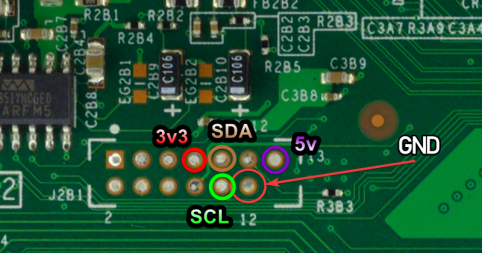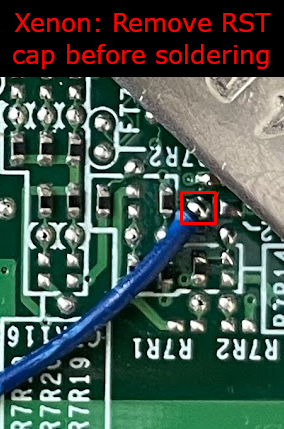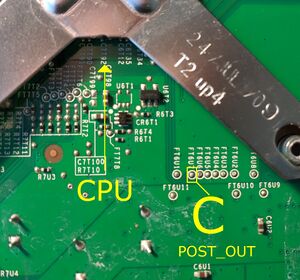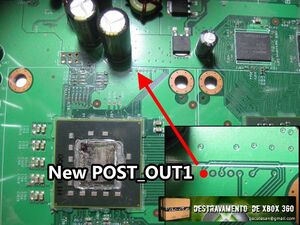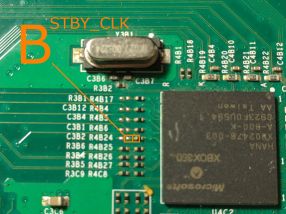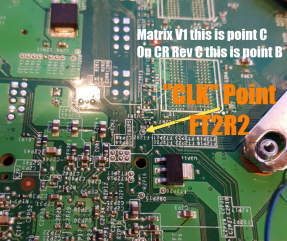Xbox 360:RGH/RGH1: Difference between revisions
m (Text replacement - "[http://www.mediafire.com/file/7orm0jrkncrzo1w/xexmenu12live.rar/file XeXMenu 1.2 rar]" to "XeXMenu 7zip file") |
(Put images directly on the page since it's more intuitive) |
||
| Line 25: | Line 25: | ||
===Motherboard points=== | ===Motherboard points=== | ||
====[[Xbox 360:RGH/Solder Points#Phat|Phat]]==== | ====[[Xbox 360:RGH/Solder Points#Phat|Phat]]==== | ||
Alternative points have been provided in the link above. | |||
===3.3v, 5v, & GND=== | |||
SDA and SCL are ignored with RGH1. | |||
[[File:J2B1.png|482x482px]][[File:Phat360PLLFix.jpg|thumb|400x400px|PLL Repair on a Phat motherboard (required if bottom pad is damaged). Image credit to TheLazyITGuy.]] | |||
===CPU_RST=== | |||
[[File:RST.png|frameless]] | |||
===POST === | |||
*Bottom | |||
**[[File:WEFEjMr.jpg|300x300px]] | |||
* Top (requires scraping) | |||
**[[File:POST_OUT1_Top.jpg|300x300px|(requires scraping)]] | |||
===STBY_CLK=== | |||
*Top | |||
** [[File:Fat360STBY CLK.jpg|frameless|286x286px]] | |||
**There are 2 points boxed; either can be used. | |||
*Bottom | |||
** [[File:CLK.png|frameless|287x287px]] | |||
===Glitch Chip Diagrams & Pinouts === | ===Glitch Chip Diagrams & Pinouts === | ||
Revision as of 02:18, 2 September 2024
| The steps on this page are considered risky for your console, as there is a chance you can brick it. Please have someone else mod your console if you are not experienced in soldering! |
RGH1 is for non-Xenon phat consoles with dashboard 14699 and lower. It uses CPU_PLL_BYPASS to slow down the CPU. While there were other RGH1-targeted chips, such as EDGE360, X360 Glitchip, and SQUIRT360; most of them are not obtainable anymore and won't be mentioned. While RGH 1.0 can be used on Zephyrs, EXT_CLK is far more reliable with those motherboards and also works on Xenon. RGH 1.2 is also much better than RGH1 on Falcon and Jasper motherboards.
Equipment Needed
- A compatible glitch chip:
- Coolrunner Rev A/B/C/D
- CR3 Lite
- Matrix
- A PC running Windows Vista or later
- A soldering iron, solder, flux, and isopropyl alcohol with cotton swabs
- J-Runner with Extras
- A NAND & Glitch Chip Flasher
- A NAND Backup with XeLL written to the console
Reading your NAND
There are a few different tools for reading your NAND chip: xFlasher 360, Nand-X, JR Programmer, Matrix USB NAND Flasher, PicoFlasher, various SD card tools, or a LPT cable. Consider the pros and cons below and choose the method that’s right for you. An LPT cable is not recommended as it's extremely slow, requires more work than other options, and cannot be used to program glitch chips.
A guide on how to dump and write to a standard NAND can be found here.
| Device | Pros | Cons |
|---|---|---|
| xFlasher 360 |
|
|
| PicoFlasher |
|
|
| JR Programmer |
|
|
| Nand-X |
|
|
| Matrix USB NAND Flasher |
|
|
| LPT Cable |
|
|
Programming the Glitch Chip
- Plug the cable from your programmer into the chip programmer. Slide switch on the CoolRunner to "PRG".
- If you are using an xFlasher, ensure the switch is set to
SPI.
- If you are using an xFlasher, ensure the switch is set to
- Open J-Runner with Extras. Click "Program Timing File" in the upper left and select your console’s tab and the relevant radio button for RGH1.
- Click "Program". When complete, unplug the cable from the glitch chip and set the switch back to "NOR".
Glitch Chip Installation
Motherboard points
Phat
Alternative points have been provided in the link above.
3.3v, 5v, & GND
SDA and SCL are ignored with RGH1.
CPU_RST
POST
STBY_CLK
Glitch Chip Diagrams & Pinouts
Coolrunner Rev A/B/C/D
- A - PLL
- B - STBY_CLK (only if not using oscillator)
- C - POST
- D - RST
CR3 Lite
- A - PLL
- B - STBY_CLK (only if not using oscillator)
- C - POST
- D - RST
Matrix Glitcher
- A - RST
- B - POST
- C - STBY_CLK (only if not using oscillator)
- F - PLL
Testing the Console
Once you've finished soldering, clean up any flux with isopropyl alcohol and cotton swabs. Partially re-assemble your Xbox 360, ensuring that:
- Heatsinks are attached (If they were removed for some reason)
- Fan(s) are in place and plugged in (On a phat console, the fans can be angled on top of the heatsinks to cool them for testing)
- The RF board is plugged into the front of the console
- An A/V or HDMI cable is plugged into the Xbox 360 and into a TV or monitor
- A power brick is plugged in to both the wall and Xbox 360
- (Optional) An ethernet cable is plugged into the Xbox 360 and a LAN (e.g. a switch, router, or directly to a PC)
Turn on your console, and it should boot into XeLL RELOADED within a minute. If you don't have an ethernet cable connected, write down (and/or take a picture of) the "CPU Key" listed on screen. If the console doesn't boot into XeLL, check all previous steps and double check your wiring accuracy and quality.
Decrypting the NAND
Once you have successfully obtained your CPU key, we can build an XeBuild image, which is a modified NAND built specifically for your console.
- If you want to use J-Runner with the console connected to LAN to get the CPU key, enter the IP address XeLL gives you into the lower right of the app. You can then click
Get CPU Keyand XeLL will automatically decrypt the retail NAND dump you backed up earlier. - If you want to use XeLL's web page to get the CPU key, enter the Xbox's IP address in your preferred web browser. You will see information about the console, and the CPU key can be easily copy and pasted from this web page.
- If you didn't have access to an ethernet cable to plug the Xbox into a PC or LAN, you can manually type the CPU key into J-Runner in order to decrypt your original NAND dump.
Writing New NAND Image (NAND Flasher)
- Power down the console, and connect your programmer to the motherboard.
- If you are using an xFlasher, ensure the switch is set to
SPI.
- If you are using an xFlasher, ensure the switch is set to
- Open J-Runner and select
...next to the Load Source field and select one of your original NAND dumps if not already selected. In the upper right of J-Runner, ensure theGlitch2radio button is selected. - Click "Create XeBuild Image". This will take a few moments.
- Click "Write NAND".
- Disconnect your NAND programmer from the console's motherboard when the process completes.
- Check if the console boots to the Microsoft dashboard. If it successfully boots to the dashboard, it is an indication that you've successfully hacked your console.
- Boot the console several times and ensure it boots consistently. If not, make sure your wiring is clean and neat and avoids noisy areas. Run the wires near the X-Clamps for best results.
- Continue in the Cleaning Up section.
Writing a New NAND Image (XeLL)
- Open J-Runner and select
...next to the Load Source field and select your nanddump1.bin or nanddump2.bin if not already selected. In the upper right corner of the window, select the dashboard version you chose for the patched dump that you wrote to the motherboard and make sure that theGlitch2radio button is selected. - Click "Create XeBuild Image". This will take a few moments.
- Copy updflash.bin to a FAT32 formatted USB storage device and plug it into your powered-off console.
- Turn on your console. It will boot into XeLL and begin flashing your NAND. Once it has finished, it will power off your console.
- Turn it back on, and it should boot to the Microsoft dashboard, which is an indication that you've successfully hacked your console.
- Boot the console several times and ensure it boots consistently. If not, make sure your wiring is clean and neat and avoids noisy areas. Run the wires near the X-Clamps for best results.
- Continue in the Cleaning Up section.
Cleaning Up
Remove your NAND programmer wires and clean the points. Clean all flux off the board, allow it to dry, and test it once more before re-assembling.
Installing XeXMenu
- Plug a flash drive into your Xbox 360 and navigate to Console Settings > Storage. Select the flash drive and allow it to format the flash drive as a system drive.
- Extract the
CODE9999folder from the XeXMenu 7zip file to your Desktop. - Plug the flash drive into your PC. Create a new folder on the flash drive and name it
0000000000000000(16 zeroes). Open the new folder, then drag theCODE9999folder into it. - Select Drive > Close, then close Xplorer360. Safely eject your flash drive and plug it into your Xbox 360. Navigate to the Demos section of your dashboard, and it should list XeXMenu there. Select it to launch it.
You can install XeXMenu to your hard drive by going to Console Settings > Storage, and copying it from your flash drive to the hard drive.
